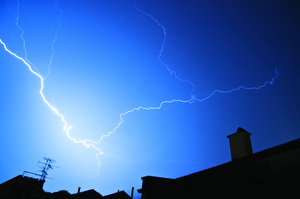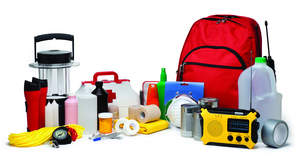MISSION, KS--(Marketwired - Sep 8, 2014) - (Family Features) Preparing for an unexpected emergency, especially one brought on by severe weather, is one of the most important ways you can protect your home and family. Proactively addressing storm-related issues ranging from property damage to power outages can minimize a potentially disastrous situation.
Step 1: Verify Your Homeowners Insurance Covers Storm Damage
Nearly all homeowners carry some form of insurance on their home, as required by their mortgage lender. But policies can vary, and the aftermath of a powerful storm is no time to find out you're underinsured.
To ensure your homeowners policy adequately covers your needs, take time to review the policy every year at renewal time, and any time you make any significant improvements to your home. Check that the coverage amount for your main residence accurately reflects the finished square footage of your home, including any upgrades or changes such as a newly renovated bathroom or expanded deck structure. Also confirm that the replacement cost your homeowners insurance agent has determined is consistent with what you would expect to pay to rebuild your home.
In addition, take time to understand any exclusions, especially those for weather-related incidents. For example, many homeowners insurance policies do not automatically include flood protection.
Finally, take time to thoroughly document your personal possessions with video or still images and record their value. Store the documentation in a safe place, such as a safety deposit box or remote-access electronic file, that you will be able to access in the event of an emergency. Not only will this help expedite your claim if you need to replace items, but you'll have a list ready when you face the daunting task of replacing your belongings.
Keep Up on Home Maintenance
Stepping outside after a significant storm is no time to remember that you forgot to trim the tree or secure a loose section of fencing. Making time to provide ongoing home maintenance for exterior features of your home, such as landscaping, decking, siding, roofing and shutters, will ensure they are in good function when bad weather strikes.
While little can be done to prevent damage from high-impact storms, routinely checking that everything is in good repair will minimize the chances of preventable destruction.
As you assess your home and yard, ask yourself: Are the trees and shrubs properly trimmed and set far enough away from structures that they are unlikely to topple in high winds? Are shutters affixed securely to the house? Are there any cracked or otherwise weakened windows that should be replaced to prevent shattering during a storm?
Prepare for Backup Power During an Outage
Loss of power is one of the most common occurrences in severe weather. And the financial impact of outage-related expenses (e.g. spoiled food replacement, supply purchases or home repair) can add up quickly.
"Storm-related power loss can be costly for a family," said Greg Inwood, vice president for Briggs & Stratton Standby Power. "An unexpected power loss can result in a number of inconveniences if the outage requires special arrangements such as meals out and overnight hotel stays."
The easiest way to prepare for a weather-related power outage is by installing a standby generator in advance of the storm season. Fortunately, attaining the safety and comfort provided by a standby generator during a storm event has become more reasonable thanks to emerging technology that has made generators smaller, smarter and, therefore, more affordable.
"In the past, having a generator was cost-prohibitive for many households," said Amanda Grandy, marketing manager for Briggs & Stratton Standby Power, which is the exclusive licensee of GE Generator Systems. "Today, technology has advanced to make owning a standby generator far more affordable for the average family."
Improved technology features such as GE's Symphony® II power management system, which manages a home's power demands automatically and electronically during an outage, allow more of a home's lights and appliances -- up to two AC units -- to be powered with a smaller standby generator. A home that would typically need a larger 20 kW home generator to power all of the home's power demands could now be powered with GE's 10 kW unit paired with Symphony® II technology. The smaller, more affordable 10 kW home generators also boast the smallest footprint on the market, making it ideal for homes with tight lot lines.
Learn more about the home standby generators available to homeowners at www.gegenerators.com.
Common Types of Backup Generators
A power outage is a common result of weather-related emergencies, but it's also one of the easiest to correct by using a generator. There are two common generator types: portable generators and standby generators.
- A portable generator is an immediate but temporary solution. Typically powered by gasoline, it is lower in cost and doesn't require installation time, but it can only power a few items for a few hours.
- A standby generator is an automatic, permanent backup power solution. It requires professional installation outside the home. It is powered by natural gas or liquid propane and turns on automatically during a utility power outage to keep a home's lights, furnace, AC units and other appliances on while the power is out.
Emergency Preparedness Kit
Having an emergency preparedness kit of items that your household may need in an emergency situation is critical. Basic utilities such as electricity, gas, water, sewage and phone service may be unavailable after a storm strikes, so the kit should contain food, water, any necessary medications, lighting and backup battery supplies.
About Family Features Editorial Syndicate
This and other food and lifestyle content can be found at www.editors.familyfeatures.com. Family Features is a leading provider of free food and lifestyle content for use in print and online publications. Register with no obligation to access a variety of formatted and unformatted features, accompanying photos, and automatically updating Web content solutions.
Contact Information:
Vickie Rocco
vrocco@familyfeatures.com
1-888-824-3337
http://editors.familyfeatures.com

